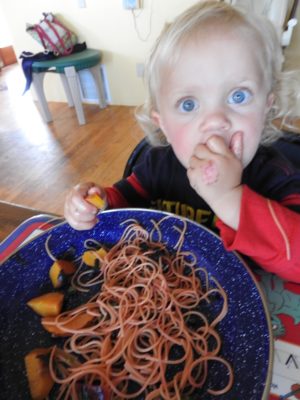
Kia’s kiddos love to help in the kitchen — and they love to eat the results!
Tips for Teaching Children to Cook Safely
By Daniel Sherwin
Teaching children to prepare food safely using kitchen tools is one of the best ways to prepare them to be self-reliant and confident around the house. It’s also an excellent way to encourage their help with chores. Kids relish the feeling of achievement they get from cooking dishes their family can enjoy together. The lessons they learn in the kitchen will stay with them for a lifetime, and they’re more likely to gain an understanding of the difference between healthy, natural foods and packaged foods that lack basic nutrition and contribute to obesity. In fact, cooking may be the one lesson they learn around the house that doesn’t feel like a chore.
Safety
Safety is always the first rule of the kitchen. Kids learn about personal safety and food safety at the same time. Food safety means ensuring that ingredients are fresh, prepared according to directions, and cooked at the proper temperatures to ensure they’re cooked through and safe for eating. The kitchen is a good place to instruct children about the need to protect everyone from bacteria and the dangers of contamination. For example, kids need to know that they should never place fresh foods on a plate that raw chicken on it just a moment before, and to always use clean and sterile utensils to prepare food.
Personal safety is an even more important lesson. There’s nothing wrong with letting your children know the seriousness of accidents that can happen in the kitchen. Kitchen knives need to be kept sharp if they’re to be effective. Yet sharp objects are a constant danger in the kitchen, and kids need to learn to handle them safely, keeping them pointed in the opposite direction and always cutting away from their hands. Sharp knives should never be placed in a container with soapy water, into which someone might put their hands unsuspectingly. Similarly, sharp knives should always be placed point down in the dishwasher to prevent inadvertent cuts. Consider having kids practice cutting food items safely to make sure they understand the principles of knife safety.
Emergency protocols
Kids should always be taught how to protect themselves and what to do in the event of a kitchen emergency. If a fire starts, they need to call for an adult right away. If there’s a small grease fire in a cooking pan, teach them never to use water to put it out, and carefully explain why. Instead, use baking soda to put out the fire. Teach them to call 911 if there’s a large kitchen fire. Test your smoke detectors on a regular basis and teach your kids never to leave the kitchen when they’re cooking something, and how to operate a fire extinguisher.
Burns are another common kitchen danger of which kids should be made aware. Make sure they know that pot handles should be turned away from the front of the stove where a metal handle could cause a nasty burn or be knocked over by an unwary young cook. Instruct your kids never to test the temperature of water with their fingers. Great care should always be taken around an open oven door and with dishes that have been heated in the microwave. Safe practices should always be taught for using a toaster (never place a metal object inside), a blender (never place fingers inside when plugged in), and the garbage disposal. All appliances should be turned off and unplugged when your kids are finished with them, and carefully wipe down all kitchen counters to prevent the spread of bacteria.
Always stay with your children while they’re learning to use kitchen tools and appliances, and explain why the lessons you teach are so important to them. As they learn to make dishes, begin with easy ones like scrambled eggs and pudding and allow them to try more complex recipes as they feel able. Gently reinforce safety lessons as needed.
For more information, Daniel recommends these sites:
Cooking – childdevelopmentinfo.com, “Why Kids Should Learn to Cook”
Contamination – thespruceeats.com – “Teach Kids Food and Kitchen Safety”
Kitchen Knives – eatyourbeets.com – “7 Tips for Teaching Your Kids How To Use a Knife”
Risk Prevention – redfin.com – “Tips to Protect Your Home from Fire”
Burns – raisingchildren.net – “Fire and Burns”
Pixabay – pixabay.com
Have you tried this recipe? Tell us how it turned out!
